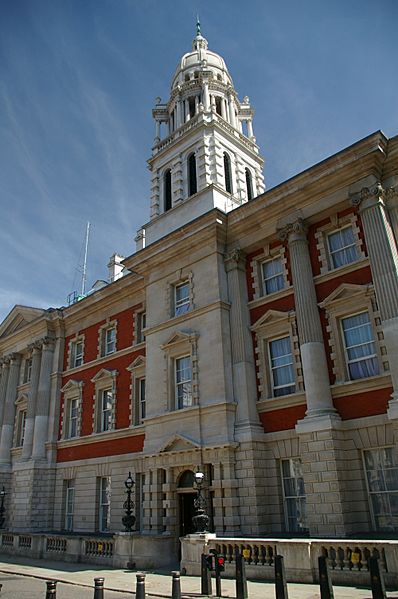Image: Old Admiralty Building 2

Description: This is the largest of the Admiralty Buildings. It was begun in the late 19th century and redesigned while the construction was in progress to accommodate the extra offices needed due to the naval arms race with the German Empire. It is a red brick building with white stone detailing in the Queen Anne style with French influences. It is now used by the Foreign and Commonwealth Office. Foreign and Commonwealth Office staff refer to the building as the OAB (Old Admiralty Building). The Admiralty complex lies between Whitehall, Horse Guards Parade and The Mall and includes five buildings. Since the Admiralty no longer exists as a department, these are now used as an office bank by the British government. The oldest building is now referred to popularly as the Old Admiralty and officially as the Ripley Building. It is a three storey u-shaped brick building, and completed in 1726. Alexander Pope implied the architecture is rather dull, lacking either the vigour of the baroque style which was fading from fashion at the time, or the austere grandeur of the Palladian style which was just coming into vogue. It is mainly notable for being perhaps the first purpose built office building in Great Britain. It contained a board room, other state rooms and offices and apartments for the Lords of the Admiralty. Robert Adam designed the screen which was added to the entrance front in 1788. Nowadays the Ripley Building is allocated to the Cabinet Office. Admiralty House is a moderately proportioned mansion to the south of the Ripley Building, built in the late 18th century as the residence of the First Lord of the Admiralty, serving that purpose until 1964. Winston Churchill was one of its occupants. It lacks its own entrance from Whitehall, and is entered through the Ripley Building. It is a three storey building in yellow brick with neo-classicistic interiors. Its rear facade faces directly onto Horse Guards Parade. The architect was Samuel Pepys Cockerell. There are now three ministerial flats in the building. Admiralty Arch is linked to the Old Admiralty Building by a bridge and is part of the ceremonial route from Trafalgar Square to Buckingham Palace. It contains further office space currently used by the Cabinet Office. The Admiralty Citadel is a squat windowless World War II fortress north west of Horse Guards Parade, now covered in ivy. Source: <a href="http://en.wikipedia.org/wiki/Admiralty" rel="nofollow">en.wikipedia.org/wiki/Admiralty</a>
Title: Old Admiralty Building 2
Credit: Flickr: Old Admiralty Building
Author: Tim Gage
Permission: This image, which was originally posted to Flickr.com, was uploaded to Commons using Flickr upload bot on 17:01, 17 January 2011 (UTC) by NotFromUtrecht (talk). On that date, it was available under the license indicated. This file is licensed under the Creative Commons Attribution-Share Alike 2.0 Generic license. You are free: to share – to copy, distribute and transmit the work to remix – to adapt the work Under the following conditions: attribution – You must attribute the work in the manner specified by the author or licensor (but not in any way that suggests that they endorse you or your use of the work). share alike – If you alter, transform, or build upon this work, you may distribute the resulting work only under the same or similar license to this one. http://creativecommons.org/licenses/by-sa/2.0 CC BY-SA 2.0 Creative Commons Attribution-Share Alike 2.0 truetrue
Usage Terms: Creative Commons Attribution-Share Alike 2.0
License: CC BY-SA 2.0
License Link: http://creativecommons.org/licenses/by-sa/2.0
Attribution Required?: Yes
Image usage
The following page links to this image:

